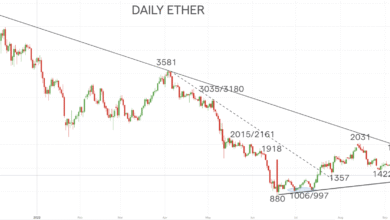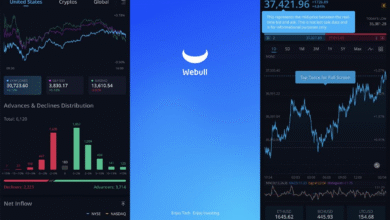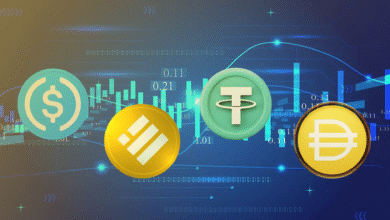Stablecoin Market Surges: USDS and USDe Supplies Spike

The stablecoin market has recently gained momentum, surpassing an impressive valuation of $264 billion, fueled by various factors including the rising stablecoin supply and significant contributions from major players like Tether (USDT). This booming sector highlights an intriguing dynamic as USDC’s market cap remains critical, even with recent fluctuations. Notably, the growth of USDe and the increase in USDS illustrate a shift towards diversification within the stablecoin ecosystem. As Tether continues to maintain a substantial 61.86% market dominance, the competition is heating up, evidenced by a remarkable 24% rise in circulating USDe supplies. In a landscape where stability is paramount, the performance of these digital assets—ranging from USDT to USDC, USDe, and USDS—shapes the future of digital currency transactions and investments alike.
The arena of digital currencies, particularly within stablecoins, is evolving significantly, attracting attention from investors and regulators alike. Terms such as fiat-backed tokens and algorithmic currencies are becoming increasingly prominent as the market expands. Recent developments indicate a shift in focus towards alternative stablecoins, such as USDe and USDS, which have shown impressive growth in their respective valuations. As the market landscape transforms, factors like regulatory changes may impact how these digital assets operate and gain traction. This emerging complexity within the stablecoin sector calls for a deeper understanding of each token’s role and implications on the broader cryptocurrency ecosystem.
Understanding the Stablecoin Market Dynamics
The stablecoin market has experienced a remarkable surge, recently surpassing the $260 billion mark. This growth is driven by increased investor interest in providing stability amidst the volatile cryptocurrency environment. Various factors contribute to the dynamics of this market, such as institutional adoption, technological advancements in blockchain, and shifts in regulatory frameworks, which together shape the landscape and viability of stablecoins as a trusted medium of exchange.
As of now, Tether (USDT) remains the dominant player, controlling over 61% of the stablecoin market share. The recent influx of nearly $2 billion in new Tether coins demonstrates its continued authority within this space. However, with emerging competitors like Circle’s USDC and newer entrants like Ethena’s USDe and Sky’s USDS, the stability and sustainability of established players are increasingly being tested. Investors are now carefully evaluating how these dynamics will influence liquidity and market confidence moving forward.
The Impact of USDS and USDe on the Stablecoin Economy
The growth of USDS and USDe has contributed significantly to the evolving landscape of the stablecoin economy, marking a nearly 25% spike in their supplies. USDS leads the current growth wave, recently achieving a remarkable 24.95% increase in its market cap due to a substantial influx of new tokens. This trend indicates a shift in user preferences and a diversification of portfolio strategies among investors as they seek alternative stablecoin options.
Similarly, USDe’s performance, with a 24.63% rise during the same period, highlights its burgeoning acceptance among users. The influx of over 1.4 billion new USDe tokens showcases the growing demand for diverse stablecoin offerings. This fragmentation within the stablecoin ecosystem not only presents opportunities for innovation and competition but also reflects an increasing maturity of this market segment. Investors, therefore, need to keep a close watch on the developments surrounding USDS and USDe as they evolve.
Analyzing Tether USDT’s Market Dominance
Tether (USDT) has firmly established itself as the cornerstone of the stablecoin market, boasting a staggering market cap of approximately $163.90 billion. Its success can be attributed to the widespread use of USDT for trading across numerous cryptocurrency exchanges, underscoring its liquidity and reliability during market fluctuations. This ubiquitous presence makes USDT a crucial component for traders looking to hedge against the volatility seen in other cryptocurrencies.
However, Tether’s dominance raises questions about potential market stability and the risks tied to a singular issuance. As other stablecoins like USDC aim to carve their niche, market observers are keen to understand how shifts in confidence and regulatory challenges could impact Tether’s dominance. The ripple effect that accompanies these changes may reshape investor behavior and prompt calls for a more diverse stablecoin portfolio.
The Role of USDC in the Stablecoin Market Cap
Circle’s USDC, holding the second-largest market cap in the stablecoin sector at $64.015 billion, continues to play a pivotal role in maintaining market balance. While slightly decreasing due to withdrawals, USDC remains a preferred choice for institutional investors seeking transparency and compliance in their transactions. This level of trust likely stems from Circle’s commitment to rigorous audit practices and regulatory adherence, which further bolster its reputation in the competitive landscape of digital assets.
Despite its recent decrease, USDC’s substantial market presence provides a counterweight to Tether’s dominance. As the demand for compliant, stable digital currencies grows, USDC is likely to benefit from increased adoption rates among businesses seeking to leverage crypto technology. Analysis indicates that the consistent presence of USDC will encourage healthy market competition, ultimately enhancing investor confidence across the stablecoin spectrum.
Emerging Competitors: A Closer Look at USDe and USDS
As the stablecoin market matures, newer entrants like Ethena’s USDe and Sky’s USDS have emerged, gaining traction among various user segments. USDe’s dramatic increase of over 24% highlights a growing interest in alternative stablecoins that may offer unique features or benefits compared to more established competitors. This burgeoning popularity signals a potential shift in market dynamics, where alternative stablecoins can extend their appeal beyond niche use-cases.
Sky’s USDS has similarly caught the attention of crypto enthusiasts, thanks to its impressive weekly gains. The competitive spirit introduced by these new players reflects an ecosystem that thrives on innovation and selection. As more liquidity flows into these emerging tokens, traditional stablecoin issuers may need to adjust their strategies to maintain their lead or risk losing market share to these disruptive challengers.
Stablecoin Regulations and Future Implications
With the introduction of new regulations under the GENIUS Act, the stablecoin market is poised for transformative changes. Regulatory frameworks will not only define the operational landscape for established stablecoins like Tether and USDC but will also create opportunities for proper compliance and legitimacy for new entrants like USDe and USDS. These regulations could enhance user trust, ensuring that stablecoins maintain their pivotal role as dependable alternatives in the digital currency space.
However, navigating these regulatory waters could either lead to strengthened positions for dominant players or pave the way for emerging tokens to disrupt the status quo. As other jurisdictions consider similar regulatory measures, the outcome of these developments will have profound implications for the stablecoin economy. Stakeholders must remain agile and informed to adapt to the shifting regulatory environment while capitalizing on new opportunities that arise.
Understanding Stablecoin Supply and Its Market Significance
The concept of stablecoin supply is crucial to understanding market dynamics, as an increase in supply often leads to fluctuations in demand and market valuation. Recent data indicates that an expanding supply of stablecoins can directly affect the overall crypto economy, affecting liquidity and price stabilization across various digital assets. As supply rises, particularly with coins like USDT, USDe, and USDS, it can signal growing trust and adoption from investors who seek security in their digital transactions.
Moreover, the interplay between stablecoin supply and market cap shifts illustrates important economic principles at play. Increased supply, such as the 1.925 billion USDT added recently, signifies confidence in the broader cryptocurrency market. Consequently, as more stablecoins are minted, such as new issuances from USDe, users have greater options for secure transactions, which enhances participation within the larger crypto ecosystem.
Market Trends Indicating Growth in the Stablecoin Economy
Recent trends in the stablecoin economy suggest a shift towards increased innovation and diversification within the sector. The notable spike in supplies of USDS and USDe illustrates a clear demand for alternatives to traditional stablecoins. This growth reflects a broader trend where users are increasingly looking for tailored financial solutions that meet their unique needs in a landscape marked by rapid digital transformation.
Furthermore, these developments may influence the strategies of established players and encourage them to innovate or enhance their product offerings. As competition heats up, the market may witness new functionalities and services associated with stablecoins, including integration with DeFi platforms and enhanced user experiences. Staying alert to these trends will be crucial for investors aiming to navigate the evolving realm of digital finance.
Investor Confidence and Its Impact on the Stablecoin Market
Investor confidence stands as a linchpin in determining the stability and growth trajectory of the stablecoin market. The notable fluctuations in the market cap of USDC, as well as the gains from emerging alternative tokens like USDe and USDS, reflect a close interplay between investor sentiment and market dynamics. Reassurances regarding regulatory compliance alongside strong supply metrics often help in bolstering investor trust.
On the other hand, shifts in this confidence could lead to significant impacts, including rapid sell-offs or mass migration to alternative tokens. Understanding these dynamics is essential, particularly as the stablecoin market continuously evolves amidst new opportunities and challenges. For investors, recognizing the key factors that drive confidence will be vital in leveraging this market effectively.
Frequently Asked Questions
What is the current state of the stablecoin market?
The stablecoin market currently holds a valuation of approximately $264.986 billion, having recently surpassed the $260 billion mark. This surge has been fueled by an influx of nearly $5 billion, notably from Tether (USDT), which commands a dominant market share.
How significant is Tether (USDT) in the stablecoin market?
Tether (USDT) represents 61.86% of the total stablecoin market, with its market cap standing at $163.90 billion. Its growth has included the issuance of 1.925 billion new USDT coins in the past week alone.
What factors are contributing to the growth of USDe in the stablecoin market?
USDe has seen substantial growth, with a 24.63% increase in supply, driven by the addition of approximately 1.425 billion new coins. This growth highlights its increasing competitiveness in the stablecoin market.
How does USDC’s market cap compare within the stablecoin market?
Circle’s USDC maintains a market cap of $64.015 billion, securing its position as the second-largest stablecoin. However, it experienced a slight decline of 0.54% recently due to the removal of 348 million USDC from assets under management.
What implications does the growth of USDS have for the stablecoin market?
The growth of USDS is notable, with a 24.95% weekly increase, bringing its market cap to $4.956 billion. This suggests an ongoing fragmentation within the stablecoin market, as new players like USDS and USDe gain traction against established giants.
How might upcoming regulations affect the stablecoin market?
New regulations, such as those proposed in the GENIUS Act, could significantly impact the stablecoin market. They may standardize compliance and oversight, potentially benefiting dominant issuers while providing opportunities for emerging challengers like USDe and USDS.
What trends are being observed in the stablecoin supply?
Recent trends in the stablecoin supply indicate robust minting activity, especially with USDT contributing significantly. The overall supply across various tokens, including new entrants like USDe and USDS, reflects a dynamic and evolving stablecoin landscape.
Are there signs of fragmentation in the stablecoin market?
Yes, the rise of alternative stablecoins like USDe and USDS amidst the established dominance of USDT and USDC indicates a growing fragmentation in the stablecoin market. This could lead to increased competitiveness and innovation among stablecoin providers.
| Stablecoin | Market Cap (Billions) | Weekly Change (%) | New Tokens Circulated (Millions) |
|---|---|---|---|
| Tether (USDT) | 163.90 | 1.19 | 1925 |
| Circle (USDC) | 64.015 | -0.54 | 348 |
| Ethena (USDe) | 7.212 | 24.63 | 1425 |
| Sky (USDS) | 4.956 | 24.95 | 990 |
| Paypal (PYUSD) | 0.891 | 2.98 | 26 |
Summary
The stablecoin market is experiencing significant growth, hitting a new valuation of approximately $265 billion. Major players like Tether (USDT) continue to dominate, yet emerging stablecoins such as USDe and USDS are gaining traction, indicating a changing landscape. As new regulations come into play, particularly the GENIUS Act, this growing segmentation within the stablecoin market could lead to future disruptions, impacting both established and new entrants.




